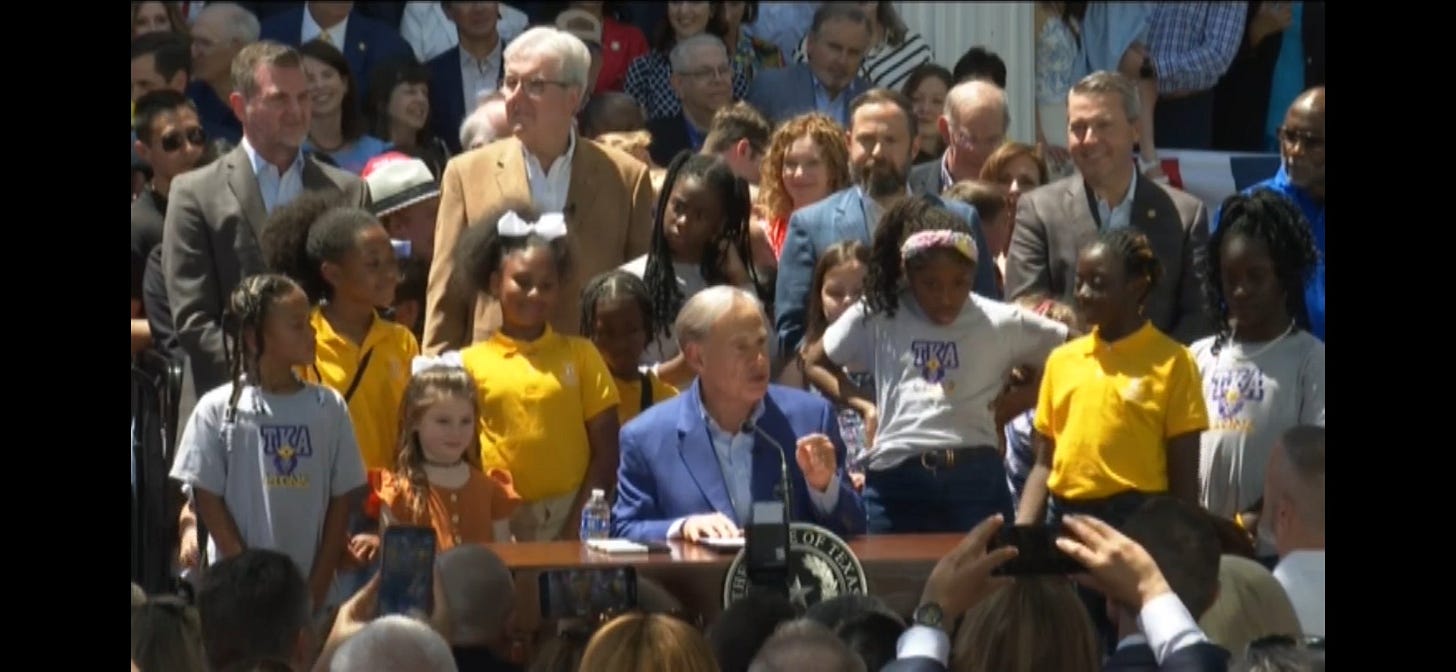Two Pots, One Problem: Will Texas School Choice Be Universal?
Watching the signing of SB 2 was personal, but it was also bittersweet.
Hello Friends!
The following commentary was originally posted as an article on X.
With Governor Abbott signing Texas’ first school choice law—SB 2—we saw a historic moment, but not yet a fully transformative one. In this piece, I explain why Texas still falls short of universal education freedom and how lawmakers must fix the two-pot funding problem holding families—and taxpayers—back. Let's finish the job and let people prosper.
Two Pots, One Problem: Will Texas School Choice Be Universal?
Big day in Texas: Governor Abbott finally signed the state’s first school choice law on Saturday. ESAs will begin in the 2026–27 school year.
For years, I’ve fought for education freedom—not just as an economist, but as someone who lived it. I started in a small private school from kindergarten through second grade, where my mom worked just to afford tuition. I then attended government schools in South Houston and Weatherford for grades 3–6, before finishing grades 7–12 as a homeschooler. After a government-run junior college, I earned my bachelor’s and PhD at Texas Tech University, a government school
That diverse education experience opened doors for me, and that's why I believe every Texas family deserves the same freedom to choose what works best for their children.
Watching the signing of SB 2 was personal, but it was also bittersweet. Yes, Texas finally passed school choice, but it’s not truly universal, not even close.
The ESA program is capped at 100,000 students—just 1.5% of Texas’ 6.3 million school-aged kids. Of those, only a strictly limited number of students from households earning above 500% of the federal poverty level—roughly $160,000 for a family of four—can even qualify.
That’s bad policy and worse economics.
When higher-income families are blocked from participating, the program loses political support, economic scale, and its ability to build momentum. Every student, regardless of income, deserves the opportunity to learn better. Each taxpayer deserves the efficiency and innovation a competitive education system can deliver.
Meanwhile, for every $1 spent on ESAs, up to $8 in new taxpayer money will go to the government-run school system. That’s hardly competition—it’s a rigged market. Texas spends more than $100 billion annually on the monopoly government school system. A small, capped ESA program won’t bring the accountability or market pressure needed to improve outcomes across the board.
Even worse, students using ESAs receive $10,000 or less yearly, while the average government school student is subsidized at more than $18,000. If ESAs were available to every student in Texas, the cost could be closer to $12,000 per child, still significantly lower than the status quo.
So when critics claim ESAs “subsidize the rich,” they’ve got it backwards. The current system gives a blanket $18,000 subsidy to high-income families who keep their kids in public schools. School choice simply levels the playing field—and at a discount.
Texas lawmakers got part of the policy right this session. However, the dual-funding structure, ESA cap, and income restrictions show how far we must go.
The correct answer is clear: end the two-pot system and adopt a single-pot funding model where every dollar follows every student, regardless of income or schooling type. That shift could save over $20 billion annually, reduce bureaucracy, and deliver the freedom and efficiency Texans deserve.
School choice isn’t about rationing opportunity—it’s about restoring it. The best thing we can do now is expand this program to all families, fully fund it, and give every Texas child a chance at a better future.





Is the one pot concept effectuated in another state? Another country? Curious to know the empirical outcomes- or anecdotal ones.